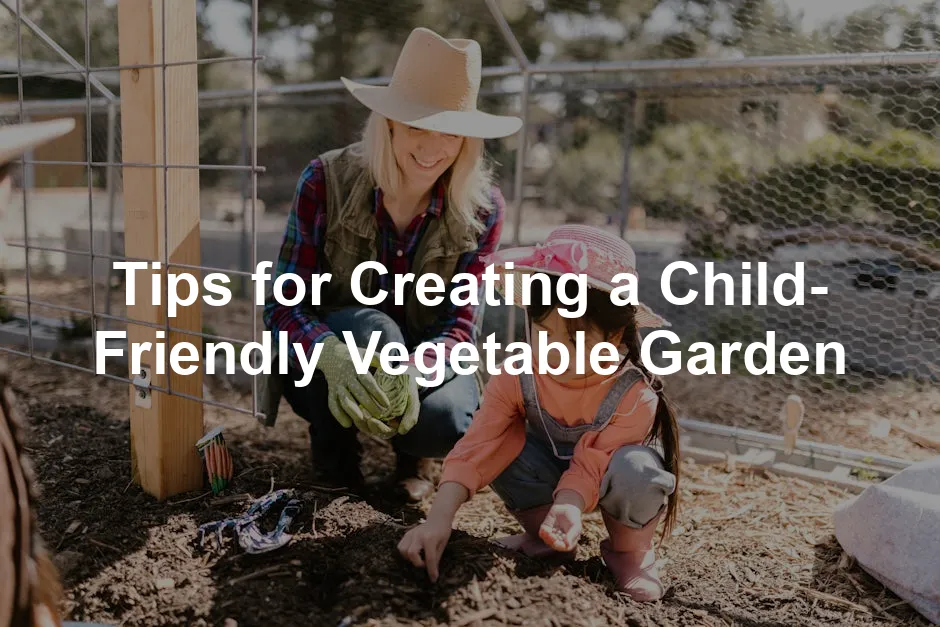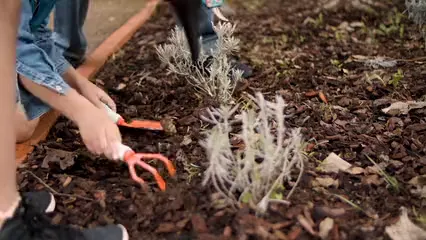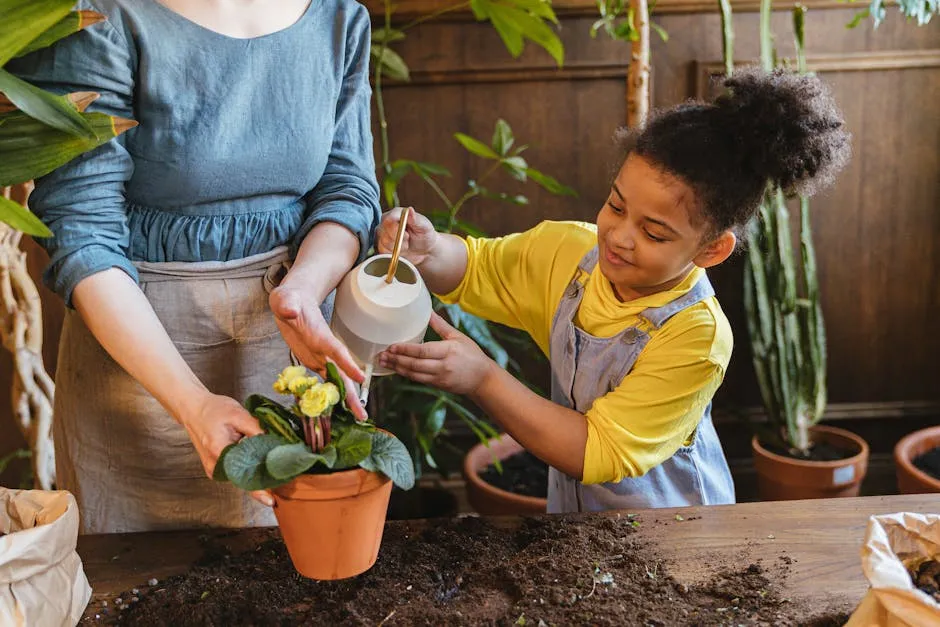

Tips for Creating a Child-Friendly Vegetable Garden
Introduction
Creating a child-friendly vegetable garden is a fantastic way to bring the family together. It’s not just about planting seeds; it’s about planting memories! Gardening offers children a hands-on opportunity to learn where their food comes from. Plus, it instills a love for healthy eating that can last a lifetime.
Imagine your kids eagerly harvesting ripe tomatoes or crunchy carrots. It’s not just fun; it’s educational! Gardening teaches responsibility, patience, and the science of growing food. Kids learn about nature, weather, and even nutrition while having a blast outdoors.
This article aims to equip parents with practical tips to create an engaging gardening experience for their little ones. From choosing the right location to making the garden accessible, let’s dig into how to cultivate a thriving vegetable garden that kids will love!

Choosing the Right Location
Importance of a Sunny Spot
Vegetables are like sunbathers; they thrive in sunlight! Most veggie plants need at least six to eight hours of direct sunlight daily. A sunny spot will ensure your plants grow strong and healthy. For optimal growth, consider a south-facing location.
To assess sunlight availability, observe the space throughout the day. Watch for shadows cast by trees, buildings, or fences. Remember, a shady garden is a sad garden! If you’re gardening in a limited space, such as a balcony, container gardens can still flourish with strategic placement.

Accessibility for Kids
Accessibility is key for keeping kids engaged in gardening. You want them to feel like they can dive right in! Choose a garden space that’s easily reachable. Consider creating raised beds or using containers at a height suitable for little gardeners.
Raised beds can be built to a height where children can easily plant and tend to their veggies without much strain. Containers are another option, as they can be moved around and placed at a perfect height for kids. This helps foster a sense of ownership and responsibility, making gardening a delightful adventure for them.
Encouraging kids to take part in the decision-making process adds to their excitement. With the right location and accessibility, your child-friendly garden will be a growing success!
Speaking of making gardening fun, a Small Garden Shovel Set for Kids can make digging a lot more enjoyable. With colorful, child-sized tools, the little ones will feel like true gardeners!

Planning Your Garden
Selecting Kid-Friendly Plants
Creating a child-friendly vegetable garden starts with selecting the right plants. Kids love to grow snacks they can munch on. Consider easy-to-grow vegetables that are also tasty. Cherry tomatoes are a hit, and they can snack right off the vine. Carrots offer the thrill of pulling them from the soil, and they come in fun colors! Peas are not only quick to sprout but also deliciously sweet.
Involving kids in the selection process is essential. Ask them what veggies they’d like to grow. This simple act fosters excitement and ownership. When children feel their choices matter, they’re more likely to take care of their plants. Plus, it’s an excellent opportunity to teach them about healthy eating. Show them pictures of different vegetables, and let them pick their favorites. A little investment in their preferences pays off big time in enthusiasm!
And while you’re at it, why not grab a Organic Vegetable Seeds Variety Pack to ensure a bountiful harvest! Nothing tastes better than veggies grown from seeds you planted together.

Garden Design Ideas
A well-planned garden design can spark creativity and joy in children. Different layouts can make gardening more fun. Traditional rows work well, but why not shake things up? Raised beds are perfect for kids. They’re easier to reach and can create a sense of adventure. Container gardens are also fantastic. They can be moved around and placed at kid-friendly heights.
Themed gardens, like a pizza garden, can captivate young imaginations. Imagine growing tomatoes, basil, and peppers all in one spot! Adding fun features can enhance the experience. Colorful borders made from painted rocks or shells can brighten the space. Create whimsical signs like “Tomato Town” or “Carrot Castle.” Kids love silly names! Trellises for climbing plants can also add a magical touch. Nothing is more exciting than watching beans or cucumbers climb!
To help with that, consider using Garden Trellis for Climbing Plants. It adds vertical interest and makes your garden look like a magical place!

Companion Planting
Companion planting is a clever gardening technique that benefits young gardeners. By planting certain vegetables together, you can improve growth and even ward off pests. It’s like a gardening team-up! For instance, tomatoes and basil thrive together. Basil not only enhances the flavor of tomatoes but also keeps pests at bay. For more on this, check out Companion planting strategies for increased yield.
Companion planting can help in maximizing your garden’s yield and keeping it healthy. Learn more about it here.
Another example is planting carrots and onions nearby. Onions can deter carrot flies, giving your carrots a fighting chance. Peas love to hang out with radishes, too. They help each other grow strong while making the garden vibrant and varied. Teaching kids about companion planting can be both educational and fun. It opens up discussions about nature’s relationships and teamwork, all while they watch their garden flourish.
With these tips, your child-friendly vegetable garden will not only grow veggies but also create lasting memories!

Engaging Children in the Gardening Process
Creating a child-friendly vegetable garden is not just about planting seeds. It’s about getting kids involved and excited about gardening! Engaging children in the gardening process can lead to valuable life lessons and a love for fresh vegetables. Below are some fantastic ways to engage your little ones in various stages of gardening, from soil preparation to daily care.
Preparing the Soil
Soil preparation is crucial for a successful garden. Think of it as laying the foundation for a fun adventure! Start with soft, crumbly soil that’s easy for little hands to dig into. Kids can help by using small shovels or their hands to mix the soil. It’s like playing in a sandbox, but with a purpose!
Adding compost and organic matter is essential. Compost enriches the soil, making it a nutritious haven for plants. Gather kitchen scraps, old leaves, and grass clippings to create a compost pile. Kids can help by collecting materials or turning the pile. It’s an excellent way to teach them about recycling and sustainability. Plus, they’ll feel proud knowing they’re helping the earth!
To make it even more engaging, consider a Compost Bin for Kids. It’s a fun way to get them involved in composting while learning about reducing waste!

Planting Together
When it’s time to plant, let the kids take charge! Show them how to plant seeds or seedlings, emphasizing the importance of spacing and depth. Each seed has its own special spot in the garden, just like each child has their unique personality. Use colorful markers for fun plant labels. Let kids decorate them with stickers or drawings. This sparks creativity and makes the garden feel personal!
Encourage them to plant in patterns or shapes. A garden can be a canvas for their imagination! For instance, they might want to plant tomatoes in a circle, creating a “Tomato Town.” Make it a game: who can plant the most seeds without overlapping? This playful approach keeps their interest piqued.

Daily Care and Responsibilities
Gardening isn’t a one-and-done deal; it requires daily care! Assign age-appropriate tasks for kids. Younger children can help with watering plants, while older kids can tackle weeding and checking for pests. This not only teaches responsibility but also instills a sense of accomplishment.
Incorporate gardening into daily routines. Set aside time each day for kids to check on their plants. Make it a fun ritual, like a mini gardening adventure! Plan a “garden morning” with breakfast outdoors. Kids can munch on fruit while inspecting their plants. Include rewards, like a freshly picked carrot as a snack after watering. This builds excitement and reinforces the joy of growing food.
Make gardening enjoyable by turning it into a game. Create a chart for tasks, and let kids earn stickers or points for completing them. At the end of the week, offer a small prize for their hard work. They’ll love the challenge and feel proud of their contributions.
Speaking of fun tasks, why not have them wear a Gardening Apron for Children? It keeps their clothes clean while they dig and plant, making them feel like real gardeners!

Encouraging children to be active participants in the gardening process creates lasting memories. Watching plants grow while nurturing them provides life lessons. They learn patience, responsibility, and the joy of eating healthy foods. With each step, they’re not just gardening; they’re growing up to be conscious, caring individuals. So, roll up those sleeves, and let the little ones dig in!

Harvesting and Using Your Produce
Celebrating the Harvest
Harvesting is like a family festival! The excitement is palpable as kids rush to the garden, eager to see what treasures await. Nothing beats the joy of plucking ripe vegetables from the vine together. It’s pure magic! This experience teaches children the fruits of their labor. They learn responsibility and patience as they watch their hard work pay off.
Incorporating freshly harvested produce into family meals can be a delightful adventure. Gather everyone to prepare a special meal together. Consider making a colorful salad with cherry tomatoes, crunchy cucumbers, and crisp lettuce. Or whip up a delicious vegetable stir-fry! Let the kids choose their favorite veggies and add them to the mix. This transforms eating into a fun, collaborative effort.
You could also create a “garden-to-table” night where everyone shares their favorite recipes featuring the harvest. Encourage kids to taste-test their creations. Nothing builds confidence like knowing they played a part in the meal! Plus, it’s a fantastic way to instill a love for healthy food. After all, who wouldn’t want to munch on veggies they grew themselves?

Teaching Cooking Skills
Teaching kids basic cooking skills is rewarding and enjoyable! Using vegetables they’ve grown makes it even more special. Start with simple recipes that require minimal ingredients and steps. A classic salad is perfect! Kids can wash, chop, and toss ingredients together. They’ll feel like mini-chefs in their own kitchen.
Another easy recipe is vegetable soup. Let kids pick their favorite vegetables and toss them in a pot with water and broth. They can stir and watch as everything simmers together. Not only will it warm the belly, but it also teaches them about flavors and textures.
Stir-fries are another fun option. Kids can help chop veggies and add them to a hot skillet. Let them experiment with different sauces and seasonings. This encourages creativity in the kitchen—something every budding chef appreciates!
These cooking experiences promote a sense of accomplishment. Children learn that healthy eating can be fun, especially when they are involved from the garden to the table. Plus, they’ll develop skills that last a lifetime!

Overcoming Challenges
Dealing with Pests and Diseases
Every gardener faces challenges, and kids need to learn how to handle them, too! Managing pests without harsh chemicals is a valuable lesson. Encourage kids to observe their plants regularly. A keen eye can spot trouble before it spirals out of control. Introduce natural pest control methods like planting marigolds to ward off aphids.
Another effective strategy is using insecticidal soap or neem oil. These options are safe for children and pets, making them perfect for a family garden. Remember, gardening is a learning process! Mistakes will happen. Celebrate these moments as teaching opportunities.
Discuss with kids what went wrong and how to fix it. This fosters resilience and problem-solving skills. They’ll learn that even seasoned gardeners encounter bumps along the way. Encouraging them to keep trying cultivates a growth mindset. With each challenge, they’ll become more adept at caring for their garden, gaining confidence as they go.

Keeping Kids Engaged
To keep kids excited about gardening, introduce new plants each season. The thrill of new growth ignites curiosity! Have themed gardening days where everyone dresses up for the occasion. Whether it’s a “pizza garden” or a “rainbow vegetable patch,” creativity keeps interest alive.
Engagement can also come from routine tasks. Set up a gardening chart that outlines each child’s responsibilities. Kids can earn stickers or rewards for completed tasks, turning chores into fun challenges. Celebrate their contributions with a mini harvest party at the end of the season.
By making gardening a fun and interactive experience, you’ll create lasting memories. Kids will cherish their time in the garden and carry these valuable lessons into adulthood. So, roll up those sleeves, and let the gardening adventures continue!
Consider adding a Kids’ Gardening Book to your collection. It’s a great way to inspire them with new ideas and techniques while making gardening even more fun!

FAQs
What are the best vegetables to grow with children?
When it comes to kid-friendly veggies, some delightful options include: Cherry Tomatoes: Sweet and easy to pick! Carrots: Fun to pull from the ground. Peas: Quick to sprout and deliciously sweet. Radishes: Fast-growing and colorful. Zucchini: Versatile and prolific. Pumpkins: A favorite for their size and fun shapes. These vegetables are not only easy to grow but also encourage kids to eat what they’ve nurtured.
How can I keep my kids engaged in gardening?
To maintain interest, make gardening fun and educational. Here are some ideas: Incorporate Games: Create scavenger hunts or challenges, like who can find the most bugs. Seasonal Themes: Celebrate each season with new plants and garden activities. Creative Journaling: Encourage kids to document their gardening journey through drawings or writings. Harvest Celebrations: Host a party when it’s time to pick veggies. Let kids help prepare a meal!
What gardening tools are appropriate for children?
Child-sized gardening tools are essential for hands-on learning. Consider these: Small Shovels and Trowels: Perfect for digging and planting. Kid-Friendly Gloves: Protect little hands while allowing exploration. Watering Cans: Lightweight options help kids water plants easily. Rakes and Hoes: Mini versions enable them to help with weeding and soil preparation. Using the right tools teaches responsibility and helps kids feel like real gardeners!
How do I teach my child about the importance of gardening?
Teaching kids about gardening can be an engaging experience. Here’s how: Hands-On Learning: Get them involved in planting, watering, and harvesting. Experience is the best teacher. Discuss Sustainability: Talk about how gardening relates to healthy eating and caring for the environment. Nature Exploration: Encourage them to observe insects, weather patterns, and plant growth. This fosters curiosity about nature. Share Recipes: Use harvested produce in meals together. This connects gardening to the kitchen and emphasizes the importance of fresh ingredients.
Please let us know what you think about our content by leaving a comment down below!
Thank you for reading till here 🙂
All images from Pexels



